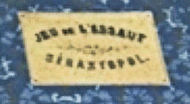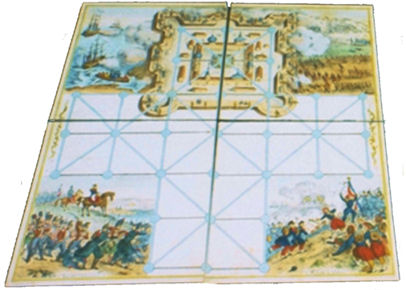
Acquired in 1982 from The Game Preserve in New Hampshire, U.S., this game was produced in the late 19th century or early 20th century by Apput Fils et Vavasseus in Paris, France. No date could be found on the box. The label in the photograph is in the center of the 20.3cm long x 21.8cm wide box lid. The bottom of the box is 20.3cm long x 22cm wide, while the box sides are 3.1cm high x 20.5cm high.
The subject of the game was a major siege during the Crimean War, lasting from September 1854 until September 1855. Allied troops (United Kingdom, French, and Piedmontese) landed in the Crimea and besieged the city of Sebastopol, home of the Tsar's Black Sea Fleet which threatened the Mediterranean. Before it could be encircled, the Russian army moved to defend Sebastopol. French and British engineers, from their base at Balaclava, directed the building of siege lines to the south of Sebastopol. Within a year, Sebastopol fell. The city was heroically defended by the Russians, and there were heavy Allied casualties. The fall of Sebastopol resulted in the defeat of Russia in the Crimean War, but also resulted in an explosion of public interest in this battle.

The colorful gameboard is 38.4cm long x 36.2cm wide when opened, and folds in quarters so that it may be stored in the box. The seams are joined by green cloth tape to enable the folding the board. The back of the board is covered in a linen-like fabric (as is the box), but the printed surface of the gameboard is a type of print on heavy cardboard.
At the bottom of the gameboard on each corner is an elaborate graphic. One is titled BATAILLE D'INKERMANN, and the other is titled BATAILLE DE L'ALMA - both are events that occurred during the siege. The matrix pattern on the board (in addition to the two graphics) is the typical 33 points of an Asalto board. At the top of the board is an elaborately designed "fort" - a standard component of an Asalto board - however, the graphics on both sides of this "fort" indicate that this is the "fort" at the entrance to the Sebastopol harbor.

The game pieces (pictured on the left) include the "besieged" pieces. These are the two black pieces which defend the fort. These wooden pieces painted black are 1.5cm diameter x 4cm high. The 24 "attackers" or allied armies are about the same dimensions as the besieged pieces, but are a stained wood color.
The game is played like all the other Asalto games, the only difference is that this game has the theme regarding the battle of Sebastopol. As in the other Asalto games, the two "besieged" pieces occupy the fort. The twenty-four "attackers" attempt to take the fort from them by occupying the nine points of the fort. Attackers may move only forward toward the fort. They cannot jump. They may move up or along any diagonal line to the fort and across the outside edge of the fort. Within the fort they may not move across the back two lines. Besieged pieces may move forward, backward, sideways, or diagonally along any line, and in addition may jump over any attacker when there is an vacant hole beyond the attacker. When a besieged piece jumps over an attacker to a vacant hole, the attacker is "captured", and is removed from the game. Besieged pieces MUST jump out of the fort when an opening makes it possible. A besieged piece may "capture" more than one attacker on a move, when the number of vacant holes makes this possible.
The game ends when the attackers occupy the nine places in the fort, or when the besieged have captured fifteen attackers
Last update March 2, 2010